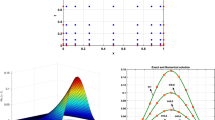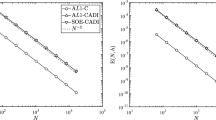Abstract
In this paper we propose fast high-order numerical methods for solving a class of second-order semilinear parabolic equations in regular domains. The proposed methods are explicit in nature, and use exponential time differencing and Runge–Kutta approximations in combination with a linear splitting technique to achieve accurate and stable time integration. A two-step compact difference scheme is employed for spatial discretization to obtain fourth-order accuracy and make use of FFT-based fast calculations. Such methods can be applied to problems with stiff nonlinearities and boundary conditions of Dirichlet or periodic types. Linear stability analysis and various numerical experiments are also presented to demonstrate accuracy and stability of the proposed methods.






Similar content being viewed by others
References
Allen, S., Cahn, J.W.: A microscopic theory for antiphase boundary motion and its application to antiphase domain coarsening. Acta Metall. 27, 1084–1095 (1979)
Certaine, J.: The solution of ordinary differential equations with large time constants. Mathematical methods for digital computers, pp. 128–132. Wiley, New York (1960)
Caplan, R.M., Carretero-Gonzalez, R.: A two-step high-order compact scheme for the Laplacian operator and its implementation in an explicit method for integrating the nonlinear schrödinger equation. J. Comput. Appl. Math. 251, 33–46 (2013)
Cahn, J.W., Hillard, J.E.: Free energy of a nonuniform system. I. Interfacial free energy. J. Chem. Phys. 28, 258–267 (1958)
Cox, S., Matthews, P.: Exponential time differencing for stiff systems. J. Comput. Phys. 176, 430–455 (2002)
Calvo, M.P., Portillo, A.M.: Variable step implementation of ETD methods for semilinear problems. Appl. Math. Comput. 196, 627–637 (2008)
Chen, L.-Q., Shen, J.: Applications of semi-implicit Fourier-spectral method to phase field equations. Comput. Phys. Comm. 108, 147–158 (1998)
Du, Q., Gunzburger, M., Peterson, J.: Analysis and approximation of the Ginzburg–Landau model of superconductivity. SIAM Rev. 34, 54–81 (1992)
Du, Q., Liu, C., Wang, X.: A phase field approach in the numerical study of the elastic bending energy for vesicle membranes. J. Comput. Phys. 198, 450–468 (2004)
Du, Q., Zhu, W.-X.: Analysis and applications of the exponential time differencing schemes and their contour integration modifications. BIT Numer. Math. 45, 307–328 (2005)
Gustafsson, B., Kreiss, H.-O., Oliger, J.: Time Dependent Problems and Difference Methods. Wiley-Interscience, New York (1996)
Hochbrucky, M., Lubich, C.: vOn Krylov subspace approximations to the matrix exponential operator. SIAM J. Numer. Anal. 34, 1911–1925 (1997)
Hochbruck, M., Lubich, C., Selhofer, H.: Exponential integrators for large systems of differential equations. SIAM J. Sci. Comput. 19, 1552–1574 (1998)
Hochbruck, M., Ostermann, A.: Exponential integrators. Acta Numer. 43, 1069–1090 (2005)
Hochbruck, M., Ostermann, A.: Explicit exponential Runge–Kutta methods for semilinear parabolic problems. SIAM J. Numer. Anal. 19, 209–286 (2010)
Hairer, E., Wanner, G.: Solving Ordinary Differential Equations ii: Stiff and Differential Algebraic Problems. Springer, New York (1999)
Jiang, T., Zhang, Y.-T.: Krylov implicit integration factor WENO methods for semilinear and fully nonlinear advection-diffusion-reaction equations. J. Comput. Phys. 253, 368–388 (2013)
Ju, L., Liu, X., Leng, W.: Compact implicit integration factor methods for a family of semilinear fourth-order parabolic equations. Dis. Cont. Dyn. Sys. B 19, 1667–1687 (2014)
Ju, L., Zhang, J., Du, Q.: Fast and accurate algorithms for simulating coarsening dynamics of Cahn-Hilliard equations. Comput. Mater. Sci. 108, 272–282 (2015)
Ju, L., Zhang, J., Zhu, L., Du, Q.: Fast Explicit Integration Factor Methods for Semilinear Parabolic Equations. J. Sci. Comput. 62, 431–455 (2015)
Krogstad, S.: Generalized integrating factor methods for stiff PDEs. J. Comput. Phys. 203, 72–88 (2005)
Kassam, A.K., Trefethen, L.N.: Fourth-order time stepping for stiff PDEs. SIAM J. Sci. Comput. 26, 1214–1233 (2005)
Lawson, J.: Generalized Runge–Kutta processes for stable systems with large Lipschitz constants. SIAM J. Numer. Anal. 4, 372–390 (1969)
Loan, C.V.: Computational Frameworks for the Fast Fourier Transform, SIAM (1992)
Li, B., Liu, J.-G.: Thin film epitaxy with or without slope selection. Euro. J. Appl. Math. 14, 713–743 (2003)
Nie, Q., Wan, F., Zhang, Y.-T., Liu, X.: Compact integration factor methods in high spatial dimensions. J. Comput. Phys. 227, 5238–5255 (2008)
Nie, Q., Zhang, Y.-T., Zhao, R.: Efficient semi-implicit schemes for stiff systems. J. Comput. Phys. 214, 521–537 (2006)
Pope, D.: An exponential method of numerical integration of ordinary differential equations. Comm. ACM 6, 491–493 (1963)
Qiao, Z., Sun, Z., Zhang, Z.: Stability and convergence of second-order schemes for the nonlinear epitaxial growth model without slope selection. Math. Comp. 84, 653–674 (2015)
Qiao, Z., Zhang, Z., Tang, T.: An adaptive time-stepping strategy for the molecular beam epitaxy models. SIAM J. Sci. Comput. 33, 1395–1414 (2011)
Spotz, W.F., Carey, G.F.: Extension of high-order compact schemes to time-dependent problems. Numer. Meth. PDEs 17, 657–672 (2001)
Temam, R.: Navier–Stokes Equations: Theory and Numerical Analysis, North-Holland (1977)
Whalen, P., Brio, M., Moloney, J.V.: Exponential time-differencing with embedded Runge–Kutta adaptive step control. J. Comput. Phys. 280, 579–601 (2015)
Wang, D., Zhang, L., Nie, Q.: Array-representation integration factor method for high-dimensional systems. J. Comput. Phys. 258, 585–600 (2014)
Xu, C., Tang, T.: Stability analysis of large time-stepping methods for epitaxial growth models. SIAM J. Numer. Anal. 44, 1759–1779 (2006)
Yang, X., Feng, J., Liu, C., Shen, J.: Numerical simulations of jet pinching-off and drop formation using an energetic variational phase-field method. J. Comput. Phys. 218, 417–428 (2007)
Zhang, J., Du, Q.: Numerical studies of discrete approximations to the Allen–Cahn equation in the sharp interface limit. SIAM J. Sci. Comput. 31, 3042–3063 (2009)
Author information
Authors and Affiliations
Corresponding author
Additional information
L. Zhu’s research is partially supported by China Fundamental Research of Civil Aircraft under grant number MJ-F-2012-04. L. Ju’s research is partially supported by US National Science Foundation under grant numbers DMS-1521965 and DMS-1215659 and by US Department of Energy under grant number DE-SC0008087-ER65393. W. Zhao’s research is partially supported by National Natural Science Foundation of China under Grant Number 11171189.
Rights and permissions
About this article
Cite this article
Zhu, L., Ju, L. & Zhao, W. Fast High-Order Compact Exponential Time Differencing Runge–Kutta Methods for Second-Order Semilinear Parabolic Equations. J Sci Comput 67, 1043–1065 (2016). https://doi.org/10.1007/s10915-015-0117-1
Received:
Revised:
Accepted:
Published:
Issue Date:
DOI: https://doi.org/10.1007/s10915-015-0117-1
Keywords
- Integrating factor
- Exponential time differencing
- Linear splitting
- Two-step compact difference
- Discrete Fourier transforms
- Runge–Kutta approximations




